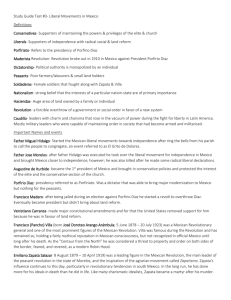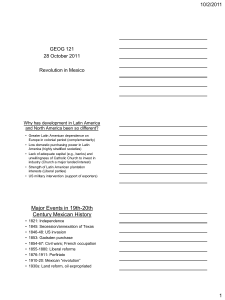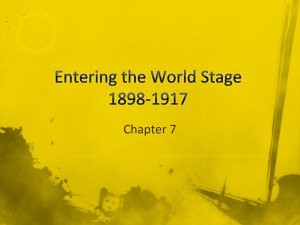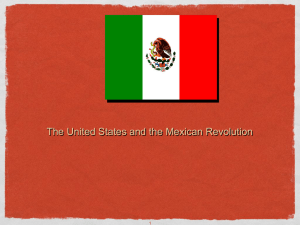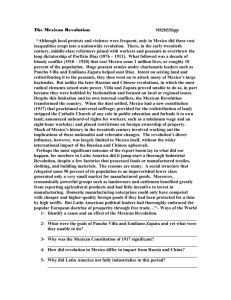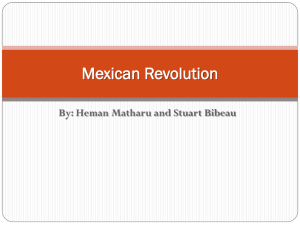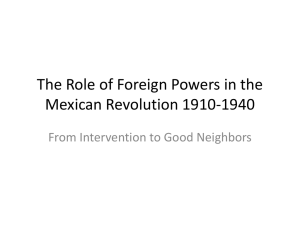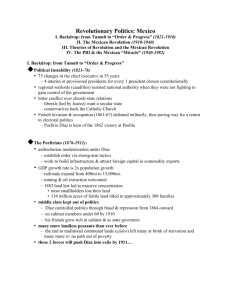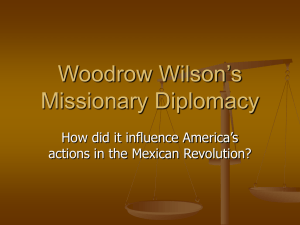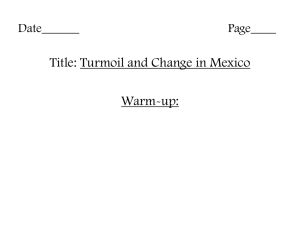Revolución mexicana - Languages Resources
advertisement
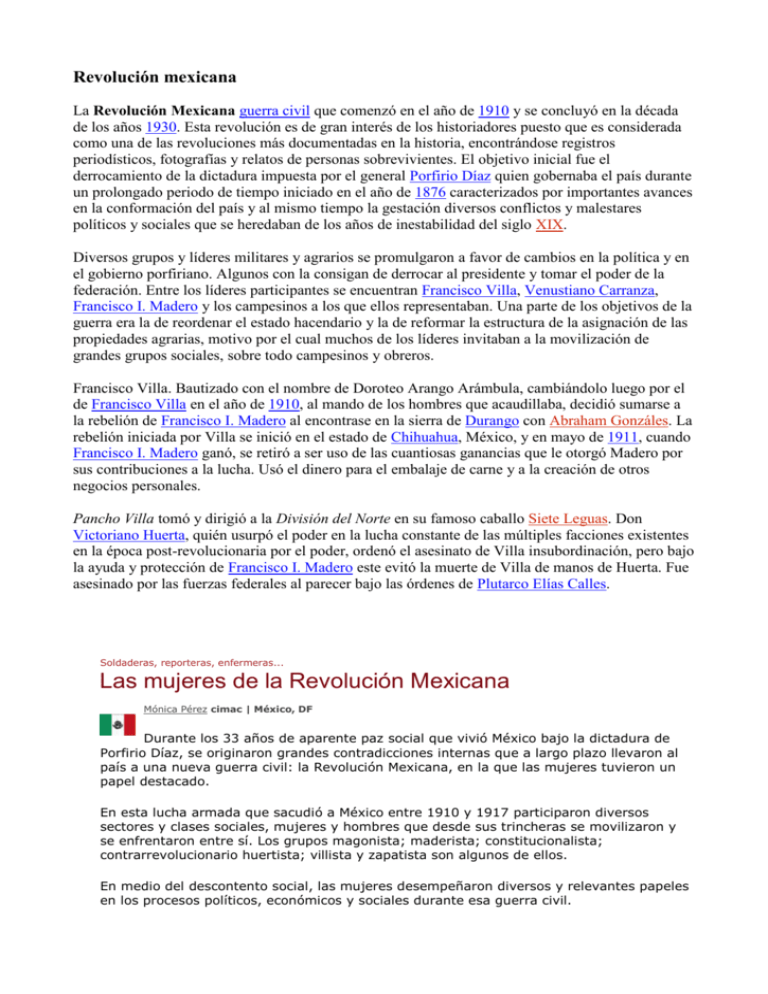
Revolución mexicana La Revolución Mexicana guerra civil que comenzó en el año de 1910 y se concluyó en la década de los años 1930. Esta revolución es de gran interés de los historiadores puesto que es considerada como una de las revoluciones más documentadas en la historia, encontrándose registros periodísticos, fotografías y relatos de personas sobrevivientes. El objetivo inicial fue el derrocamiento de la dictadura impuesta por el general Porfirio Díaz quien gobernaba el país durante un prolongado periodo de tiempo iniciado en el año de 1876 caracterizados por importantes avances en la conformación del país y al mismo tiempo la gestación diversos conflictos y malestares políticos y sociales que se heredaban de los años de inestabilidad del siglo XIX. Diversos grupos y líderes militares y agrarios se promulgaron a favor de cambios en la política y en el gobierno porfiriano. Algunos con la consigan de derrocar al presidente y tomar el poder de la federación. Entre los líderes participantes se encuentran Francisco Villa, Venustiano Carranza, Francisco I. Madero y los campesinos a los que ellos representaban. Una parte de los objetivos de la guerra era la de reordenar el estado hacendario y la de reformar la estructura de la asignación de las propiedades agrarias, motivo por el cual muchos de los líderes invitaban a la movilización de grandes grupos sociales, sobre todo campesinos y obreros. Francisco Villa. Bautizado con el nombre de Doroteo Arango Arámbula, cambiándolo luego por el de Francisco Villa en el año de 1910, al mando de los hombres que acaudillaba, decidió sumarse a la rebelión de Francisco I. Madero al encontrase en la sierra de Durango con Abraham Gonzáles. La rebelión iniciada por Villa se inició en el estado de Chihuahua, México, y en mayo de 1911, cuando Francisco I. Madero ganó, se retiró a ser uso de las cuantiosas ganancias que le otorgó Madero por sus contribuciones a la lucha. Usó el dinero para el embalaje de carne y a la creación de otros negocios personales. Pancho Villa tomó y dirigió a la División del Norte en su famoso caballo Siete Leguas. Don Victoriano Huerta, quién usurpó el poder en la lucha constante de las múltiples facciones existentes en la época post-revolucionaria por el poder, ordenó el asesinato de Villa insubordinación, pero bajo la ayuda y protección de Francisco I. Madero este evitó la muerte de Villa de manos de Huerta. Fue asesinado por las fuerzas federales al parecer bajo las órdenes de Plutarco Elías Calles. Soldaderas, reporteras, enfermeras... Las mujeres de la Revolución Mexicana Mónica Pérez cimac | México, DF Durante los 33 años de aparente paz social que vivió México bajo la dictadura de Porfirio Díaz, se originaron grandes contradicciones internas que a largo plazo llevaron al país a una nueva guerra civil: la Revolución Mexicana, en la que las mujeres tuvieron un papel destacado. En esta lucha armada que sacudió a México entre 1910 y 1917 participaron diversos sectores y clases sociales, mujeres y hombres que desde sus trincheras se movilizaron y se enfrentaron entre sí. Los grupos magonista; maderista; constitucionalista; contrarrevolucionario huertista; villista y zapatista son algunos de ellos. En medio del descontento social, las mujeres desempeñaron diversos y relevantes papeles en los procesos políticos, económicos y sociales durante esa guerra civil. De acuerdo con Martha Eva Rocha Islas, investigadora de la Dirección de Estudios Históricos del Instituto Nacional de Antropología e Historia, las mujeres se incorporaron a “la bola” por primera vez en la revolución; compañeras de soldados (se les conoce como soldaderas), se vieron enroladas en los ejércitos, desempeñando además de las tareas tradicionales, las que surgieron como parte de la guerra. Las soldaderas, en su gran mayoría mujeres campesinas, se encargaban del trabajo doméstico en condiciones adversas, lavaban la ropa, cuidaban a los hijos y alimentaban a los ejércitos; pero además atendían a los heridos, fueron espías en los pueblos, trasportaban armas y eran compañeras sexuales. Sin embargo, la labor de las mujeres durante la lucha armada no sólo se limita al ámbito privado. También participaron como telegrafistas, enfermeras, empleadas de oficina, reporteras, editoras de periódicos, maestras, entre otros oficios y profesiones. La participación de las mujeres en el ámbito político fue de vital importancia. Las magonistas, como Juana Belén Gutiérrez y Dolores Jiménez y Muro, llevaron a cabo un movimiento para liberar a los presos políticos en 1911; las maderistas Teresa Arteaga y Carmen Serdán formaron grupos antirreeleccionistas y difundieron los principios de la democracia. En el movimiento que apoyó a Venustiano Carranza la presencia de las mujeres también fue destacada. Ahí encontramos a Hermila Galindo quien sostenía que la participación activa de las mujeres debía darse tanto en los asuntos políticos del país como en los privados. Ella fue una de las feministas más importantes en México entre 1915 y 1919. El 16 de enero de 1916, cuando se llevó a cabo el Primer Congreso Feminista de Yucatán, que reunió a 700 mujeres destacadas de toda la república, representa un avance en la lucha por los derechos de las mujeres mexicanas. El congreso fue convocado por el gobernador yucateco Salvador Alvarado, 13 meses antes del Congreso Constituyente al final de la Revolución Mexicana. Como resultado de esta reunión las mexicanas ganaron el derecho a la administración de bienes, la tutela de hijas e hijos y salario igual a trabajo igual. Gracias a la lucha que sostuvieron las mujeres durante la revolución sus demandas fueron incorporadas a la legislación y plasmadas en leyes tales como la Ley del Divorcio con Disolución de Vínculo, promulgada por Venustiano Carranza en 1914, la Ley Sobre Relaciones Familiares expedida de 1917 y la Ley del Matrimonio, que decretó Emiliano Zapata en 1915. Finalmente el 5 de febrero de 1917 fue promulgada la Constitución Mexicana. En el articulo 123 se determinaron protecciones relativas al desempeño del trabajo femenino orientadas al rubro de la salud durante el embarazo y a la realización de trabajos que exigieran esfuerzos considerables. 2003/MP/MEL Mexican Revolution The Mexican Revolution or Mexican Civil War, was a period of political, social and military conflict and turmoil that began with the call to arms made on 20 November 1910 by Francisco I. Madero. It eventually culminated in the overthrow of dictator Porfirio Díaz Mori and Madero's rise to presidency. Madero, however, was deposed in 1913 and the country was engulfed in civil war, as several political and armed groups fought each other for control of the country. Major conflict finally ceased with the promulgation of the present constitution of Mexico in 1917, the official end of the Revolution. Nonetheless, conflict and political unrest persisted up to the late 1920s. In 1936, president Lázaro Cárdenas arrested and deported Plutarco Elías Calles, the ex-president who had controlled the 3 previous puppet presidents and had hoped to control Cárdenas as well. This act would mark the beginning of post-revolutionary Mexico, characterised by the rule of the Partido Nacional Revolucionario founded by Elías Calles in 1929, and later to be known as the Partido Revolucionario Institucional (PRI). Causes The Mexican Revolution was a violent social and cultural movement which brought the beginning of changes in Mexico. The changes in turn brought a sense of freedom to the citizens of its country. The revolution started because of the actions of the Mexican President Porfirio Díaz. His regime not only favoured the involvement of the United States in Mexican life but also was centered on expanding the Mexican economy. If successful, this would have eventually classified Mexico as a capitalist country. The Díaz regime can be considered the main cause of the revolution but the governments who followed him can be seen as factors in the continuation of the revolution. Francisco Madero, Victoriano Huerta, Pancho Villa and Venustiano Carranza were all important individuals in the revolution because of the role they played in attaining a stable government in Mexico. All four leaders were important in gaining a sense of what was important to the people of Mexico and what was needed to gain stability and freedom in Mexico. Emiliano Zapata can be seen as a Mexican hero because of the stand he took against Porfirio Díaz. Zapata helped the peasant class take back their land and regain Mexico as their own nation. These individuals are significant when classifying important individuals who were seen in the revolution. The Zapatistas were members of Zapata’s revolutionary guerilla groups. They took their name from Zapata who led these groups into attaining a stable Mexico. These guerilla groups were important in involving the Mexican population in their government. Guerilla groups were seen all across Latin America and were highly effective because of their ability to organize and attack in small groups. The effects of the Díaz regime were greatly felt in agrarian land reform. Laws were implemented to benefit foreign investors. The Díaz regime confiscated large sections of land from the people of Mexico. The Mexican Revolution saw new agrarian land laws passed to give back the people what was rightfully theirs. The laws were seen as an important step in achieving a stable government and country. The involvement of women in the Mexican Revolution was substantial, especially because of the way they were regarded in the early 20th century. Women took part in politics and in life on the battlefields. This was a significant advancement for women because their role in the revolution became as important as a male role. The United States also played a vital role in the Mexican Revolution. Early on they wanted to stabilize the Díaz government to ensure that relations between the two countries would remain stable. This would also ensure that the foreign trade between the two countries would remain. United States involvement in the Mexican Revolution began as monitoring the revolution and ended in militaristic intervention. Further, the Mexican Revolution influenced the United States with the increase in immigrants from Mexico to the U.S. and their push for change in Mexico from across the border. The role the Mexican Catholic Church during the Revolution is also an important aspect because of the many transformations it takes. The Roman Catholic Church in Mexico has a very influential role during the course of Mexican history. This role was greatly altered during the course of the revolution. The youth movement in any revolution is important because youth are seen as the future of a nation. In Mexico, the results were not very positive because the many university students had been given the title of anti-revolutionaries. They were accused of being unaccepting of the ideals and beliefs of the revolution. Mexican culture, such as cinema, music and literature, was also a driving factor in gaining support during the revolution. All parts of the culture were organized to show people that change was needed in order to gain a free Mexico. Mexican nationalism was an evident theme among most music, cinema and literature because of the way it could persuade people to join the fight. The Mexican Revolution is found to be similar to the many revolutions of Latin America. The revolution was one of the first to recognize labor rights, which made it a significant event in the world’s history. [edit] The End of Porfirio's rule General Porfirio Díaz, President of Mexico. Taken from the Library of Congress. After Benito Juárez’s death in 1872, Porfirio Díaz wanted to take over as Mexico’s leader. Both men were allies and had fought against the French in the Battle of Puebla, but once Juárez rose to power in Mexico, Díaz tried to unseat him. Díaz began his reign as president and dictator of Mexico in 1876 until 1911 when Francisco Madero succeeded him. Díaz’s time in office is remembered for the advances he brought in industry and modernization at the expense of human rights and liberal reforms. The era of Porfirio Díaz’s government from 1876-1911 is known as Porfiriato. Díaz had a strict “No Re-election” policy in which presidents could not serve in back to back terms in office. He followed this rule when he stepped down after his first term to Manuel Gonzalez, one of his underlings. The new president’s period in office was marked by corruption and official incompetence, so that when Díaz stepped up in the next election he was a welcome replacement. In future elections, Díaz would conveniently put aside his “No Re-election” slogan and ran for president in every election. Díaz became the dictator he had warned the people of and against. Through the army, the rurales, and gangs of thugs he frightened people into voting for him. If bullying citizens into voting for him failed, he simply rigged the votes in his favour. By using force to stay in office, Díaz knew he was violating Mexico’s constitution as well as his own liberal beliefs, but he justified his act by claiming Mexico was not yet ready to govern itself. Only he knew what was best for his country and he enforced his belief with a strong hand; Order, followed by Progress was the watchwords of his rule. While Díaz’s presidency was characterized by promotion of industry and the pacification of the country, it came at the expense of the working and farmer/peasant classes, which generally suffered extreme exploitation. The Mexican economy took a great leap during the Porfiriato, especially through the encouragement of construction such as factories, roads, dams, industries, and better farms. This resulted in the rise of an urban proletariat and the influx of foreign capital (principally from the United States.) Progress came at a heavy price though since civil liberties, such as freedom of the press, were suspended under the Porfiriato. The growing influence of United States involvement, was a constant problem for Díaz since most land in Mexico had been lost to the United States. As a result, wealth, political power, and access to education were concentrated in just a handful of families with large estates as well as some companies of foreign origin (mostly from the United Kingdom, France, and the United States). An important consequence of Díaz’s actions taken in power were the changes and eventual set backs he made to land reforms. New land laws virtually undid all the hard work leaders, such as Juárez, before him had done causing no peasant or farmer to claim his own land unless he held a formal legal title. Small farmers were helpless, and angry. A change of power would be necessary if Mexico was ever to continue being successful. From this cause, many leaders including Francisco Madero, Pancho Villa and Emiliano Zapata would launch a revolution against Díaz, escalating into the eventual Mexican Revolution. The end of the Porfiriato is by most historians documented as the beginning of the Mexican Revolution. In a 1908 interview with the U.S. journalist James Creelman, Díaz stated that Mexico was ready for democracy and elections and that he would step down and allow other candidates to compete for the presidency. Francisco I. Madero answered the call for candidates. Although Madero was very similar to Díaz in his ideology, he hoped for other elites in Mexico to rule alongside the President, unlike Díaz. Díaz, however, did not approve of Madero and had him jailed on election day in 1910, provoking the Mexican Revolution. [edit] Francisco I. Madero's presidency Francisco I. Madero in 1910 stated that he would be running in the next election against Díaz for leadership of Mexico. In order to ensure Madero did not win, Díaz had him thrown in jail and declared himself the winner. Madero soon escaped and fled for a short period of time to the United States. On November 20, 1910, Madero issued the Plan de San Luis Potosi, which declared the Díaz regime illegal and initiated a revolution against Porfirio Díaz. Madero’s promise of agrarian reforms attracted many of the peasants throughout Mexico, and he was able to gain much needed support from them in order to remove Díaz from power. Madero's army with the assistance of the Indians fought Díaz's army and had a bit of success. Díaz's army was gradually losing control of Mexico and his administration started to fall apart. In a separate tactic, Díaz jailed Madero since he was worried that Madero could potentially win the election and take over control of Mexico. Once he was released mass amounts of public protest occurred due to the election fraud which Díaz created. The desire to remove Díaz was so great that many native Indians and different leaders during this time were in support of Madero and fought on his side. On May 21, 1911 an agreement was made that stated Díaz would abdicate his rule and be replaced by Madero, after Madero had defeated the weak federal army months earlier. An overwhelming majority elected Francisco I. Madero president of Mexico in 1911. He was able to establish a liberal democracy and received strong support from the United States and popular leaders such as Zapata and Pancho Villa. Madero was a weak leader and quickly lost much of his support while he was in power. His refusal to enact land reforms caused a break with Zapata who announced the Plan de Ayala, which called for the return of lands “usurped by the hacendados” (hacienda owners) and which demanded an armed conflict against the government. The rural working class, who had supported Madero, now took up arms supporting Zapata. The people’s support of Madero quickly deteriorated. His time as leader was short lived and came to an end after General Victoriano Huerta, who was previously appointed as Madero’s commander in chief, when Madero first claimed power, staged a coup d’etat. Following Huerta’s coup d'état, Madero was forced to resign. Francisco Madero, along with vice president José María Pino Suárez, were both executed less than a week later. [edit] Victoriano Huerta's reign In early 1913, Huerta, who commanded the armed forces, conspired with U.S. Ambassador Henry Lane Wilson to remove Madero from power. La Decena Tragica was an event, which ten days of sporadic fighting occurred between federal troops led by Victoriano Huerta and Díaz’s conservative rebel forces, which still operated in Mexico. This fighting would stop when Huerta and Henry Lane Wilson met and signed the “Pact of Embassy” in which they agreed to conspire against Madero to install Huerta as president. When Huerta gained power and became president of Mexico, most powers around the world acknowledged him as the rightful leader, however incoming president of the United States, Woodrow Wilson, refused to recognize Huerta as the leader. Henry Lane Wilson was soon removed from office. On March 26, 1914, Venustiano Carranza issued the Plan de Guadalupe, which was a refusal to recognize Huerta as president and called for a declaration of war between the two factions. Leaders such as Villa, Zapata, Carranza and Obregón led the fighting against Huerta. In April of that year, American opposition to Huerta had reached its peak when American forces seized Vera Cruz. In late July, this situation worsened for Huerta and he was forced to vacate the presidency and flee to Puerto Mexico. [edit] Legacy After Huerta vacated the presidency he soon left for Spain where he would make his new home, only later to return and try to establish another counterrevolution inside Mexico. The German government, which favoured Huerta while in power, considered him to be very important to the war that was breaking out in Europe at this time. If Huerta could establish himself once again as leader of Mexico, which the German government hoped for, the United States would be distracted on both fronts and would give the Germans an advantage and a better chance to win the war. Huerta then moved to the United States and this operation of holding down another revolution inside Mexico begun and was funded by the German government. The United States government, along with the newly elected president Venustiano Carranza, became worried upon his arrival and set up a counter surveillance system to watch Huerta’s every move and make sure that Huerta would not gain entry into Mexico and bring about another counterrevolution. The United States government along with Venustiano Carranza’s forces refused at all costs to let this happen. Victoriano Huerta would not survive long enough to re-enter into Mexico and bring about the counterrevolution. He was stopped in Texas by the United States government and was kept there under house arrest, until he died in early 1916. [edit] Pancho Villa Francisco "Pancho" Villa came from the northern state of Durango and was one of the leaders of the Mexican revolution. Villa along with the support of the Villistas joined the ranks of the Madero movement. His army of Villistas participated in many battles such as the attack of Ciudad Juárez in 1911 (which overthrew Porfirio Díaz and gave Madero power), the Battle of Celaya and many others. In 1911 Pancho Villa served under Victoriano Huerta who appointed him chief military commander. During this period Huerta and Villa became rivals. In 1912 when Villa’s men seized a horse and Villa decided to keep it for himself, Huerta ordered Villa’s execution for insubordination. The execution of Villa as ordered by Huerta did not occur due to the intervention by Raúl Madero, who was brother of President Madero. Villa was jailed in Mexico City and then escaped to the United States and soon after the assassination of President Madero he returned with a group of companions to fight Huerta. By 1913 that group had become the base of Villa's División del Norte (Northern Division), which was an army led by Villa which also had a substantial number of American members. Villa and his army, along with Carranza and Obregón, joined in resistance to the Huerta dictatorship. Villa and Carranza had very different ways of thinking and became enemies. When Carranza took control in 1914, Villa formed a rebellion. In 1915, Villa took part in two of the most important battles during the revolution which were the two engagements in the Battle of Celaya, one which took part from 6-7 April and the other from the 13-15 April 1915. Villa was defeated by Obregón in the Battle of Celaya which was one of the bloodiest battles during the revolution, one in which Carranza emerged as winner of the war and seized power. A short time after, the US recognized Carranza as president of Mexico and on March 9, 1916 Villa crossed the US-Mexico border and attacked Columbus, New Mexico. During this attack eighteen Americans were killed as well as ninety of Villa’s men; the attack made the US look at Villa as more of a bandit than a revolutionary and led to an unsuccessful pursuit US troops, who failed to locate Villa. In 1920, Alvaro Obregon signed a peace treaty with Villa, and Villa retired from the revolution. Villa was later killed in 1923 when his car was showered with bullets. [edit] Venustiano Carranza Venustuano Carranza became head of the new president of Mexico in 1914, after he overthrew the Huerta government. He was driven out of Mexico City by Villa and Zapata in 1915, but later gained the support of the masses by the development of a program of social and agarian reform. He was then elected as president of Mexico in 1917. In an attempt to restrain the slaughter, Carranza formed the Constitutional Army with an eye towards bringing peace via adoption of the majority of the rebel social demands into the new constitution. He managed to incorporate most of these demands into the new Constitution of 1917. The constitution addressed foreign ownership of resources, an organized labour code, the role of the Roman Catholic Church in education and land reform. Although his intentions were good, the Carranza government did not last or enforce many of the reforms in the Constitution of 1917, and caused greater decentralization of power. In 1920, General Álvaro Obregón who had served as Minister of War and of the Navy, revolted against Carranza along with other leading generals Plutarco Elías Calles and Adolfo de la Huerta. Carranza was assassinated on May 21, 1920; Carranza had already had Zapata killed in 1919. [edit] Emiliano Zapata Main article: Emiliano Zapata Emiliano Zapata Salazar (August 8, 1879 – April 10, 1919) was a leading figure in the Mexican Revolution against the dictatorship of Porfirio Díaz that broke out in 1910. He is considered to be one of the outstanding national heroes of Mexico; the Zapatistas, a revolutionary movement based in the state of Chiapas, take their name from him. Towns, streets, and housing developments called "Emiliano Zapata" are common across the country and he has, at times, been depicted on Mexican banknotes. There are controversies on the portrayal of Emiliano Zapata and his followers, on whether they were bandits or revolutionaries. Many Mexican Presidents, including Porfirio Díaz and Venustiano Carranza, identified Zapata as a womanizer, barbarian, terrorist, and bandit. Conservative media nicknamed Zapata ‘The Attila of the South’. To many Mexicans, specifically the peasant and indigenous citizens, Zapata was a practical revolutionary who sought the implementation of liberties and agrarian rights outlined in the Plan de Ayala. He was a realist with the goal of achieving political and economic emancipation of the peasants in Southern Mexico, and leading them out of severe poverty. Zapatistas Zapatista originally referred to a member of the revolutionary guerrilla movement founded around 1910 by Zapata, whose Liberation Army of the South (Ejército Libertador del Sur) fought during the Mexican Revolution for the redistribution of agricultural land. Zapata, his army and allies, including Pancho Villa at one point, fought for agrarian reform in Mexico and specifically the establishment of communal land rights for Mexico's indigenous population. The majority of Zapata’s supporters were the indigenous peasants, usually local, from Morelos and surronding towns. But there were intellectuals from urban areas who also joined the Zapatistas, and played a significant part in their movement, specifically the structure and communication of the Zapatista ambitions. Zapata received only a few years of limited education in Morelos, and thus the educated members from foreign towns played a large role in expressing Zapata’s political aims. These urban intellectuals were known as ‘city boys’, and were predominately young males. They were influenced in joining the Zapatistas due to many reasons, including curiosity, sympathy, and ambition. Zapata agreed that politics should be left up to the intellectuals, but also kept his role in proclaiming the Zapatista ideology. The city boys also provided medical care, helped promote and instruct the Zapatista ideology, created an agrarian reform, aided in rebuilding destroyed villages by government forces, formed manifestos, and sent messages from Zapata to other revolutionary leaders. Zapata's compadre Otilio Montaño was one of the most prominent city boys. Before the revolution he was a professor, and during the revolution he taught Zapatismo, recruited citizens, and wrote the Plan de Ayala. Other well known city boys were Abraham Martinez, Manuel Palafox, Antonio Díaz Soto y Gama, Pablo Torres Burgos, Gildardo Magaña, Dolores Jimenez y Muro, Enrique Villa, and Genaro Amezcua. [edit] Zapatista women Many women were involved and supported the Zapatistas. Since Zapata's political ambitions and campaign were usually local, the women were able to aid the Zapatista soldiers from their homes, and provided them with tortillas. There were also female Zapatista soldiers since the beginning of the revolution. When Zapata met with President Madero on July 12, 1911, he was accompanied by his troops. Amongst these troops were female soldiers, and some of them were officers. Some women were the leaders of bandit gangs during and before the revolution. Women joined the Zapatistas as soldiers for various reasons, including retaliation for dead family members or merely to perform raids. Perhaps the most popular Zapatista female soldier was Margarita Neri, who participated as a Zapatista commander. Although many female soldiers fought bravely as Zapatista soldiers, were killed in battle, and others continued to wear men's clothing and carry pistols long after the Revolution ended, La Coronela Maria de la Luz Espinosa Barrera was one of the very few who received a pension as a veteran of the Mexican Revolution. Agrarian land reform Under the Porfiriato rule, the rural peasants suffered the most. The regime confiscated large sections of land which resulted in many landless farmers. In 1883 a land law was passed which gave ownership of more than 27.5 million hectares of land to foreign companies. By 1894, one fifth of Mexico was owned by businesses from abroad. Many wealthy families also possessed land resulting in many rural peasants working on the property as slaves to their owners. In 1910, the beginning of the revolution, about one half of the rural population called a plantation (settlement or colony) home. [edit] Women in the Mexican Revolution Women during the Mexican Revolution were held under the shadow of men and had occupied the roles of wife and ultimate care givers. The Mexican Civil Code which was passed in 1884, restricted the limitations of women at home and in the workplace. The code created inequalities amongst women and ethnic minorities suffering politically, socially, economically and religiously under the Porfirian regime. For decades there have been myths circulating that portray Mexican women as timid and passive beings whose contribution and involvement in the Mexican Revolution was minimal. The truth however is that Mexican women were active participants in the Mexican Revolution, one of the most recognized social uprisings of the twentieth century. Women's involvement in the revolution had an immense impact on the shaping of Mexican society during the revolutionary period. Mexican women were essential to the revolution in a number of ways. They were involved in politics, were strong advocates for the causes they believed in, and participated in life on the battlefields. The female political figures were probably the most important and influential women in the Mexican Revolution. They were prominent political activists, thinkers, writers, figures, role models, and were fearless in their pursuit of their goals, often resulting in confinement. The Mexican Revolution had many movements focusing on dealing with the urban and middle class societies, who had finally gained the upper hand resulting in a new Revolutionary Constitution in 1917.
